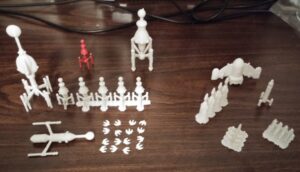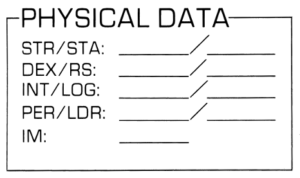This post originally appeared on the now-defunct Arcane Game Lore blog.
In part 3 of this series I worked through selecting a unified set of ability scores that I felt could be used in both of my visions for the skill system of my game. What I forgot to think about, until the very end of that essay, was the scale and range of the ability scores. That’s today’s topic.
In the first part of this series (Designing Out Loud – Ability Scores – part 1) I briefly discussed the different ranges that the ability scores could take. In part 2, before I worked out a unified set of ability scores, I discussed my thoughts and ideas on the values of the ability scores in the two different systems I was contemplating. After part 3, I need to revisit this and see if I can come up with a unified solution.
Ability Scores Are Tied To The Mechanics
and especially to the skill system. I’ve talked about this in the previous parts so I’m not going to rehash it in any great detail but just give a quick overview.
In what I’m now thinking of as my “basic” game, the ability scores are much more intimately tied to the skills than in the “advanced” game. And since the skill list is going to be smaller and more general, there will be many more checks against the ability scores in that system. As such, and since in both cases, I’m looking at a d100 percentile based system, it makes sense for the ability scores to be on a 1-100 scale directly. Ability scores in a smaller (say 2-20) range would need to be multiplied by some factor in order to be on the necessary scale.
The other system, however, doesn’t have the tight coupling of ability scores to skills and the ability scores only affect the skills as small modifiers. Thus in this case, we would prefer ability scores that are relatively small so that we can give +/- 1 skill modifiers based on the value of the ability scores above or below a certain threshold. Ability scores in the 1-100 range would require division by something (probably 5) to give the desired skill modifiers.
Is The Math Really That Bad?
The real question is how cumbersome is doing that bit of math? Personally, I don’t think twice about basic multiplication or division, but then again, I’m a Ph.D. astronomer who’s worked as a software developer for over a decade – math just comes naturally to me.
Let’s look at the four scenarios and see when we’d be doing the math. From here on out we’ll call the Star Frontiers style skills XP Skills, and the RuneQuest style skills, NoXP Skills. The ability scores on the 1-100 scale will be called d100 ability scores and the smaller range ones will be called 2d10 ability scores (even though I don’t know the exact range I’ll be using, if at all).
Case 1 – XP Skills, d100 Ability Scores
This is the “native” case for this system. The skills are based on 1/2 the ability scores which run in the same percentile range as we want for the skills. The only math involved here is the division by 2 and then addition of 10 times the skill level and other positive or negative modifiers when a skill is used. But those modifiers will exist regardless so they really don’t count. And when you make ability score checks, which are more important in this system, you just roll d100 against your ability score. So this option has effectively no math happening based on the coupling of the ability scores to the skills.
Plus with the ability scores on the larger scale, you can have finer variations between characters. Is that really necessary or even noticeable? Probably not, but it is there.
Case 2 – XP Skills, 2d10 Ability Scores
In this case, the ability scores are not on the same scale as the skill rolls (Of course we could change the skill resolution mechanic off of a d100 system but that’s not really what is wanted). So whenever you use a skill you’d have to be multiplying the relevant ability score by some factor (probably 2 or 3) to get it on the right scale. Is that harder than diving by 2? Probably not. But it’s probably not any easier either.
Plus when making ability score checks, you’d either have to not use d100 (not desired) or multiply the ability score by some factor (in this case probably 4 or 5) to get it into the d100 scale. This would have to be done more often since these ability checks are more common with this skill system.
So this one is slight more math intensive during play as you have a few more multiplications going on.
Case 3 – NoXP Skills, 2d10 Ability Scores
This is the “native” case for this skill system. The ability scores don’t figure directly into the skills but only with modifiers based on the skill category and ability score’s value above or below a certain threshold. In this case the modifiers are simple +/- 1 for each point the ability score is above or below the threshold. However, those modifiers are static and so can be computed once when the character is generated and only have to ever be recomputed if an ability score changes.
This still has the problem that ability score checks have to be multiplied by a factor to make a d100 check against them. But cases for this are much rarer in this system since many of the situations where these would be used are often covered by skills.
Case 4 – NoXP Skills, d100 Ability Scores
In this case, you don’t want the skill modifiers to be a simple +/-1 for points of ability scores above or below threshold as you would get some really large modifiers. You have to make it +/-1 skill point modifier for every N ability score points (where N is probably 5). This seems like a lot of work but remember, this only has to be done once at character creation and at the odd times a character increases one of his ability scores (how often that happens is debatable but in my experience not very common with this skill system). Plus it’s easy to provide a quick look-up table to give the appropriate modifier based on the ability score so the math is reduced to simple addition and subtraction.
And in this system, the rare ability score checks can be made directly against the scores themselves with not multiplication needed.
Modifiers
One thing I didn’t mention above is modifiers on ability score checks. In the the 2d10 ability score systems, difficulty modifiers can be applied simply by changing the score multiplier. So an easy check might be rolling d100 against the ability score x5 or x6 while a more difficult check could be x3 or x4 and a really hard check could be x2 or even x1. In the d100 ability score system, the difficulty modifiers will typically be subtracted from the ability score, i.e -0 to -10 for relatively easy checks, up to -50 to -60 for really tough ones. So the math exists regardless, it just varies in flavor.
Balancing the Scales
In the above analysis, I’ve been blithely throwing around multiplying or dividing by 5 to convert between the 2d10 and d100 ability scores but is that really the right value? Based on the maximum value it is, but what about based on the real ranges?
In the 2d10 system, your maximum value is 20 and it is possible for you to have a character starting out at that value. In the d100 system, however, you can’t start at the maximum ability score of 100. In fact, the best you can do is 75. Of course the flip side is true as well. The 2d10 system lets you have ability scores as low as 2 but the d100 system only lets you start as low as 30.
Converting the 2d10 system to d100 by multiplying by 5 means that on the 1-100 scale you can have ability scores in the range of 10-100 while the native d100 ability score range from 30-75. Going the other way means that the native 2d10 ability scores range from 2-20 but the converted d100 scores only range from 6-15. Both are basically centered on an average of 11 (in the 2d10 system) but the d100 ability scores come from a much narrower distribution. You don’t have large heroic outliers in the d100 system.
And using different multipliers don’t really help unless you start introducing more complicated formulas. Division by 4 instead of five takes the d100 ability scores down into the range of 8-19, now centered on 13.5 and skewed high. One solution is to allow a larger range in the d100 ability scores either via the ability score creation table or simply going crazy with the dice and rolling the full 10d10 to generate your ability score. That latter option would actually give you the same converted 2-20 range and basically the same distribution but that’s a lot of dice to roll (80d10 total), even if you do it only once at character creation.
So which is worse, having a wider range of ability scores that could potentially give you >90% success chances at things (that require an ability score check) even as a starting character, or having a narrower ability score range that provides less benefit to your skills and increased failure probabilities?
Reaching a Decision
So there are really two things to decide. First, what’s the scale of the ability scores, 2d10 or d100, and second do we allow the full range or a limited sub-range for starting characters?
After working through the above discussion and the previous three blog posts, I think that I’m going to move forward developing a d100 ability score system with the narrower range that I laid out back in part 2. It’s the “native” ability score system for the “basic” game skill system and I think that it really doesn’t have many negatives if applied to the other skill system. The main downside is the more complicated calculations that are needed to determine the skill category modifiers in that system but that can really be overcome with a small table of values.
The smaller ability score range simply means smaller skill modifiers in the NoXP skill system. However, these are small to begin with and this means you’d only be getting +0 to +7 bonus instead of +5 to +15 typically so you’re really only out about 5-8 percentage points on your skills. It’s a noticeable but fairly small difference that I’m completely comfortable with.
So that’s where I’ll start. We’ve finally reached the end of this set of posts and we’ll have to see how it goes.
As always, feel free to leave comments, suggestions, or questions below.



